You might have been exposed to the term “orange wine” in recent years, whether on a hip restaurant wine list, or on the shelves of your favorite bottle shop. But, for many, the term still can be confusing.
A subcategory that has been steadily on the rise, it essentially is wine made from white grapes that have spent time macerating with the skins. Red wines get color and structure primarily from a soak with their deeply hued skins, but not all reds are the same shade or intensity. This is a factor of both time and grape variety.
Likewise, white wine left in contact with its skins ranges in color from sunshine yellow to peachy rose and, yes, even deep orange.
Instead of orange wine, we prefer the term skin-contact wine, to avoid any confusion. While that phrase might come off as sterile or clinical, it is much more helpful in consumer understanding of this as a technique in winemaking, rather than a rigid category. There are no official rules that one is required to follow, in terms of grapes used, length of time on the skin, or in what type of vessel it must be aged.
Perhaps because of this freedom, the technique has become popular with winemakers who support natural winemaking philosophies, buck the traditions of commercial winemaking and desire to make wine with minimal intervention or additives. In addition to color and texture, the extended skin contact often can coax out aromas and flavors you might not normally associate with a particular grape. It also can take expected flavors and heighten them in a technicolor way.
Here are a few skin-contact whites that we’ve been enjoying this spring, and which are approachable introductions to the style.
Union Sacré Edelzwicker skin-contact white. This wine is from Alsace, by way of Paso Robles, California. It’s a blend of pinot blanc, pinot gris, sylvaner, riesling, gewürztraminer and muscat ottonel. Lush with floral, melon and apricot tones, this wine is a beautiful, blushing shade of pink.
Vinyes Tortuga Fruita Analogica Little Fluffy Clouds. It’s a blend of macabeo and muscat de Alexandria grapes sourced from Catalonia, Spain. One week of maceration with the skins gives it a delicate peach parfait hue and brings out the delightfully floral aromas of the muscat grapes.
Breaking Bread marmalade orange wine. A delightfully cheery blend of muscat blanc, chardonnay and sauvignon blanc, this wine hails from Sonoma, California. The fruit is left on the skins for 10 days before being destemmed and fermented. There is truth in advertising, as this wine is rich with aromas of tangerine marmalade and orange blossom.
Christina orange wine. It’s made from chardonnay, welschriesling and sauvignon blanc grown in the Carnuntum region of Austria, and the grapes are fermented spontaneously in contact with the skins for 18–21 days. This wine is complex, with notes of tropical fruit, bright herbs and a subtle nuttiness.
The Slaters are beverage industry veterans and the proprietors of the Expat, Slater’s Steakhouse and the Lark Winespace in Athens.
Sign up for the AJC Food and Dining Newsletter
Read more stories like this by liking Atlanta Restaurant Scene on Facebook, following @ATLDiningNews on Twitter and @ajcdining on Instagram.
About the Author
The Latest
Featured


